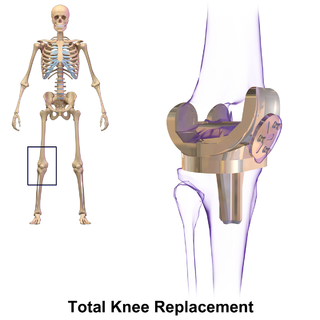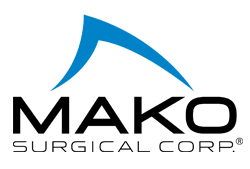
Orthopedic surgery or orthopedics is the branch of surgery concerned with conditions involving the musculoskeletal system. Orthopedic surgeons use both surgical and nonsurgical means to treat musculoskeletal trauma, spine diseases, sports injuries, degenerative diseases, infections, tumors, and congenital disorders.

Hip replacement is a surgical procedure in which the hip joint is replaced by a prosthetic implant, that is, a hip prosthesis. Hip replacement surgery can be performed as a total replacement or a hemi/semi(half) replacement. Such joint replacement orthopaedic surgery is generally conducted to relieve arthritis pain or in some hip fractures. A total hip replacement consists of replacing both the acetabulum and the femoral head while hemiarthroplasty generally only replaces the femoral head. Hip replacement is one of the most common orthopaedic operations, though patient satisfaction varies widely. Approximately 58% of total hip replacements are estimated to last 25 years. The average cost of a total hip replacement in 2012 was $40,364 in the United States, and about $7,700 to $12,000 in most European countries.

Knee replacement, also known as knee arthroplasty, is a surgical procedure to replace the weight-bearing surfaces of the knee joint to relieve pain and disability, most commonly offered when joint pain is not diminished by conservative sources. It may also be performed for other knee diseases, such as rheumatoid arthritis. In patients with severe deformity from advanced rheumatoid arthritis, trauma, or long-standing osteoarthritis, the surgery may be more complicated and carry higher risk. Osteoporosis does not typically cause knee pain, deformity, or inflammation, and is not a reason to perform knee replacement.

Joint replacement is a procedure of orthopedic surgery known also as arthroplasty, in which an arthritic or dysfunctional joint surface is replaced with an orthopedic prosthesis. Joint replacement is considered as a treatment when severe joint pain or dysfunction is not alleviated by less-invasive therapies. Joint replacement surgery is often indicated from various joint diseases, including osteoarthritis and rheumatoid arthritis.

Unicompartmental knee arthroplasty (UKA) is a surgical procedure used to relieve arthritis in one of the knee compartments in which the damaged parts of the knee are replaced. UKA surgery may reduce post-operative pain and have a shorter recovery period than a total knee replacement procedure, particularly in people over 75 years of age. Moreover, UKAs may require a smaller incision, less tissue damage, and faster recovery times.
Kevin Robert Stone is an American physician, orthopedic surgeon, clinician, researcher, and company founder of The Stone Clinic and the Stone Research Foundation in San Francisco.
Professor Derek McMinn is a British orthopaedic surgeon and inventor.
Michael J. Bronson is an American orthopaedic surgeon who is Chairman of the Department of Orthopedic Surgery, Mount Sinai West and Mount Sinai Morningside, and Chief of Joint Replacement Surgery at the Icahn School of Medicine at Mount Sinai in New York, and the author of advances in the development of minimally invasive surgical instruments to advance unicondylar partial knee replacement, including the Vision Total Hip System, a widely used hip replacement system that avoids the use of cement.

MAKO Surgical Corp. was a publicly traded medical device company based in Florida. On September 25, 2013, the Board of Directors of Mako Surgical accepted a deal to be acquired by Stryker for $1.65B. The deal closed in December 2013.

Khaled J. Saleh is a board-certified orthopaedic surgeon specializing in the diagnosis and treatment of orthopaedic conditions, and is known for surgery relating to adult reconstruction and joint replacement. Saleh's work has been supported by nearly $7 million in grant funding, resulting in over 200 scientific publications.
The following outline is provided as an overview of and topical guide to trauma and orthopaedics:

Orthopedic surgery is the branch of surgery concerned with conditions involving the musculoskeletal system. Orthopedic surgeons use both surgical and nonsurgical means to treat musculoskeletal injuries, sports injuries, degenerative diseases, infections, bone tumours, and congenital limb deformities. Trauma surgery and traumatology is a sub-specialty dealing with the operative management of fractures, major trauma and the multiply-injured patient.
Ashok Rajgopal is an Indian orthopaedic surgeon, credited with close to 20,000 Arthroscopic and over 35,000 Total Knee Arthroplasty surgeries and reported to be one of the most experienced in his field in India. He was honoured by the Government of India in 2014, by bestowing on him the Padmashri, the fourth highest civilian award, for his services to the fields of orthopaedic surgery. He has also been awarded the Dr. BC Roy award by the Medical Council of India to "Recognize the Best Talents in Encouraging the Development of Specialties in Different Branches in Medicine" for 2014.
Yash Gulati is an Indian orthopedic surgeon and the senior consultant orthopaedic surgeon at Indraprastha Apollo Hospitals, New Delhi. He specializes in joint replacement and spine surgeries and is a visiting consultant at RAK Hospital, Ras al-Khaimah. He is the youngest orthopedic surgeon to win the civilian honour of the Padma Shri.
Steven B. Haas is chief of the Knee Service at Hospital for Special Surgery (HSS) and has developed multiple innovative surgical techniques and instrumentations to improve and facilitate knee replacements. Haas has been awarded numerous patents for his initiatives. One of Haas's most significant contributions to knee surgery was developing the Minimally Invasive Knee Replacement, which allowed patients to have much smaller scars and speedier recoveries. Haas has been listed on New York magazine's annual "Best Doctors in New York" list since 2007 and has more than 100 orthopedics-related publications. He travels to present on topics pertaining to knee surgery.
Gopal Krishna Vishwakarma, more popularly known as G K Vishwakarma, was an eminent orthopedic surgeon, academician and public health administrator. He was the Director General of Health Services from October 1986 to his retirement in October 1992. He was awarded the Silver Jubilee Award (1983) and the Dr. B. C. Roy Award by Medical Council of India, The Government of India, in recognition of his contributions to the field of medicine and public health honored him with the Padma Shri (1985) one of India's highest civilian awards in India.
Dr. Javad Parvizi is an American Board Certified orthopaedic surgeon and the director of clinical research at the Rothman Orthopaedic Institute, Philadelphia. He holds the James Edwards Professor Chair of Orthopaedics at Thomas Jefferson University. He is the co-founder of the International Consensus Meeting and President of the Musculoskeletal Infection Society (MSIS).
Muthana Mithqal Sartawi is a Kuwaiti orthopedic surgeon specialized in joint replacement surgery. He is best known for inventing the Modified Intervastus Approach surgical approach used in total knee replacement surgery. He has operated on notable individuals including Saud bin Fahd Al Saud and was part of the medical team that performed the knee replacement for George W. Bush.
Justin Peter Cobb is a British professor of orthopaedic surgery at Imperial College London, known for introducing medical robotics into orthopaedic surgery. He is a member of the Royal Medical Household and was royal orthopaedic surgeon to the Queen. He is on the staff at King Edward VII's Hospital (KEVII) and is civilian advisor in orthopaedics to the Royal Air Force (RAF). His research has also included themes relating to designing new devices such as for ceramic hip resurfacing, 3D printing in orthopaedics, and training in surgical skills. He is a director of the MSk laboratory based in the Sir Michael Uren Hub.








